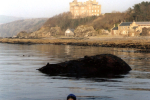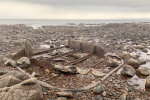Ordered by the Admiralty the steel Castle class armed trawler Thomas Twiney (FY3528) was launched from the Middlesborough yard of Smith’s Dockyard Company Ltd on 20th July 1917 (Yard No.707). She measured 125.5′ x 23.4′ x 12.8′ and her tonnage was 275 gross tons, 107 net tons. She was powered by a triple expansion steam engine by the builder delivering 87 registered horse power. With the end of Word War One she was decommissioned and later purchased in 1922 by J Pettit & Company of London, converted to a fishing vessel and re-named Clyro (M245). The vessel was purchased in November 1934 by the Boston Deep Sea & Ice Company of Fleetwood.
Girvan lifeboat and the Ballantrae rocket life-saving brigade were called to assist when the Clyro went ashore just just before midnight on Tuesday 13th August 1935. She had grounded on reefs just south of Culzean Castle and maroons and flares were immediately fired. These alerted residents of the castle who telephoned the Girvan lifeboat which was launched around 12.30am. The RNLI motor lifeboat Lily Ann arrived on scene about an hour later and found that six persons were already ashore and that the remaining eight crew were either in the ship’s lifeboat alongside the Clyro or working on board to try and save their ship.
Local help had arrived before the lifeboat. Mr Edward Flynn, a local resident from Maidens, had also seen the maroons and had launched in his small motorboat to try to help the stricken crew, assisting in the landing of the first party of six. Work to stem the flow of water into the wreck continued until mid afternoon when the skipper, Ernest Wood, decided that the damage to his vessel was too severe and decided to abandon ship. The lifeboat and tug were stood down and both left the scene.
On Thursday 15th August the wreck was visited by a representative of the owners and a surveyor from their insurers. After a fairly short inspection it was decided to abandon the Clyro. The crew assisted with the transfer of any salvageable items to another Fleetwood trawler, before collecting their belongings. The crew left Culzean and their ship late afternoon and began their long journey home to Fleetwood.
The Clyro had been badly holed and was beyond economical salvage and repair. Her registry was closed on 21st October 1935. Over following weeks she developed a list and later broke in two. We have been unable to establish if the Clyro was sold or if any formal salvage work took place.
The remains of the Clyro lie approximately 500 metres south of Culzean Castle, in position 55° 21.239’N, 04° 47.794’W. Another aid to location is provided by a small stone structure on the cliff edge directly inshore known as the Powder House although this is only visible during winter months due to tree foliage. There are a number of pieces of wreckage along the shore, including the wheelhouse floor directly inshore of the boiler. The wreck is completely broken up and may have been subject to some salvage work. The most recognisable parts are her engine, rudder, propeller and boiler with the latter breaking surface at low water on spring tides. The seabed here is predominantly rock and boulders, depths range from 0-4 metres. The site is exposed to wind and swell from south west round to north, and can only really be dived by boat.




































